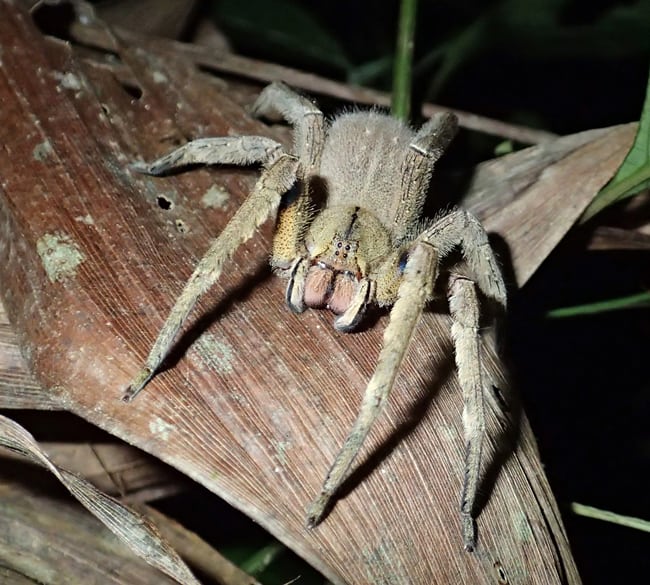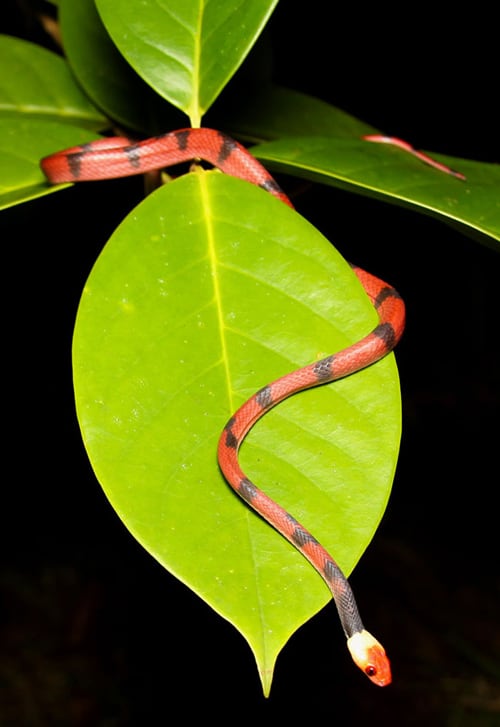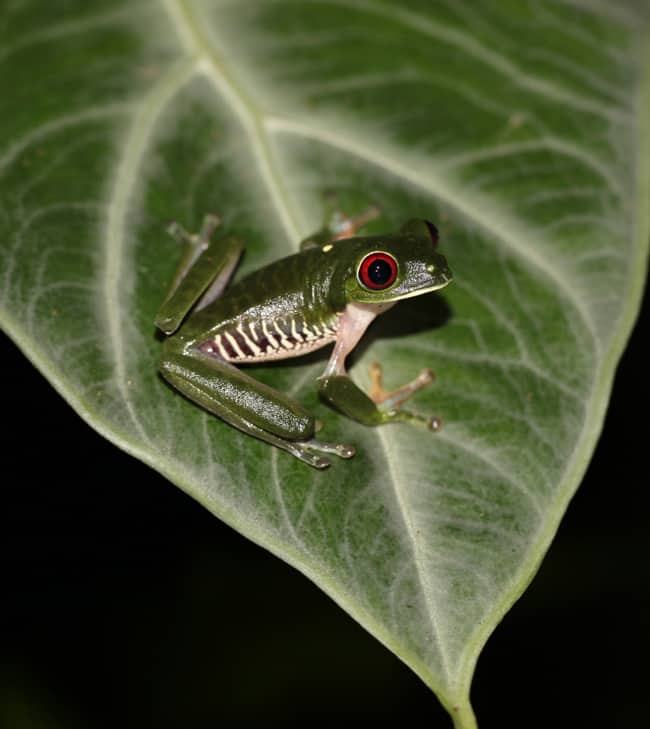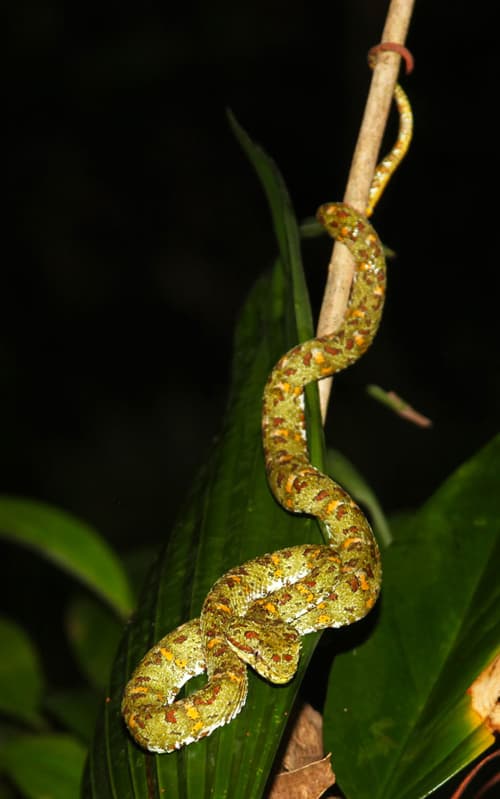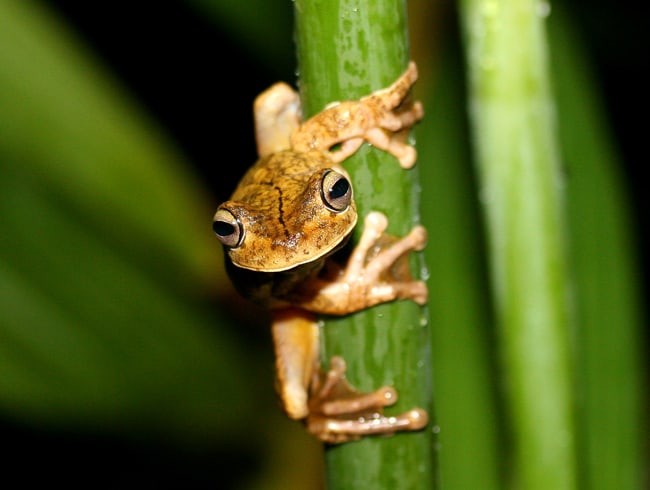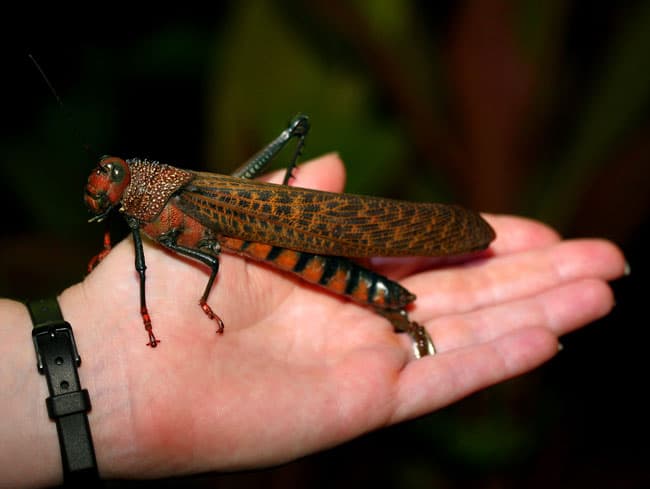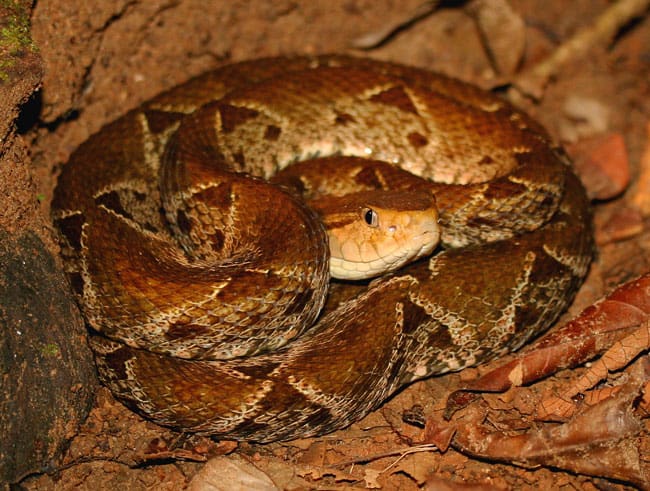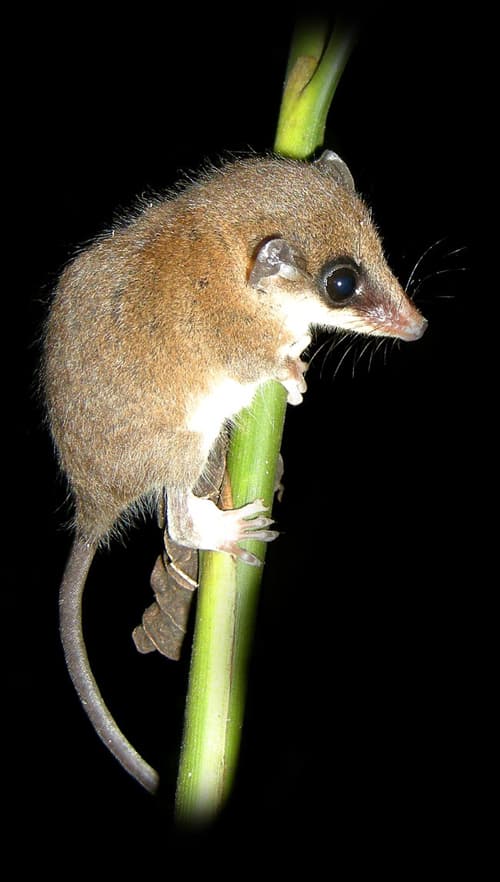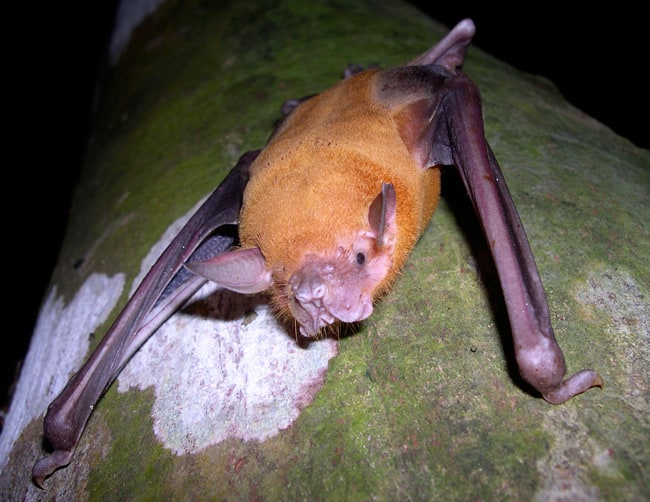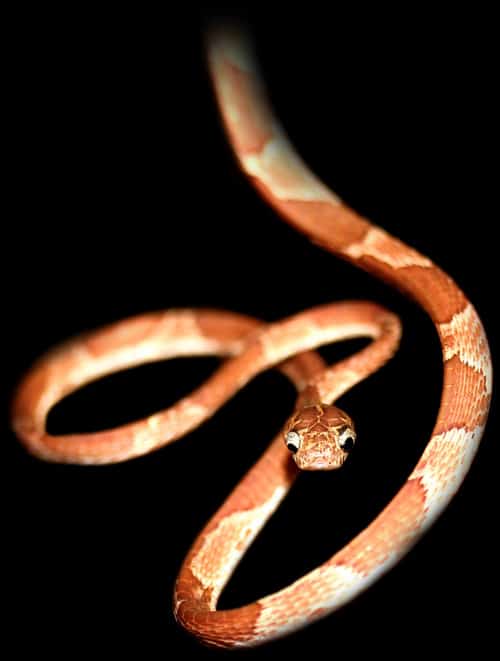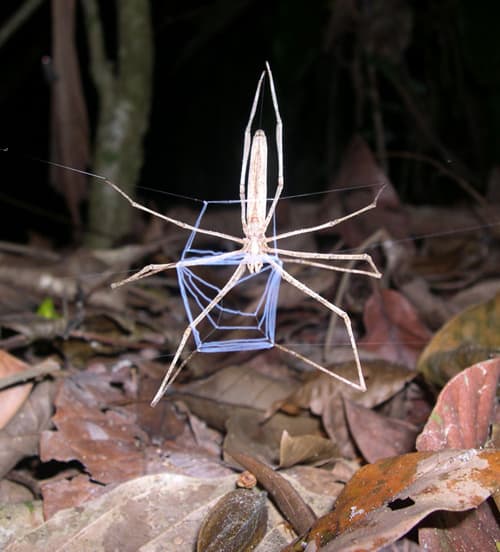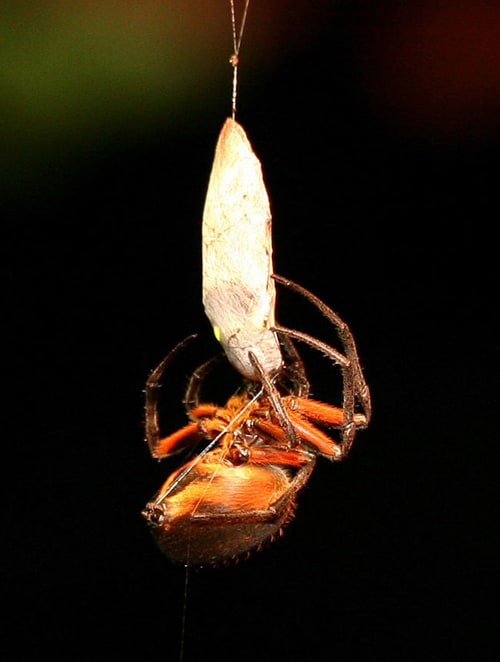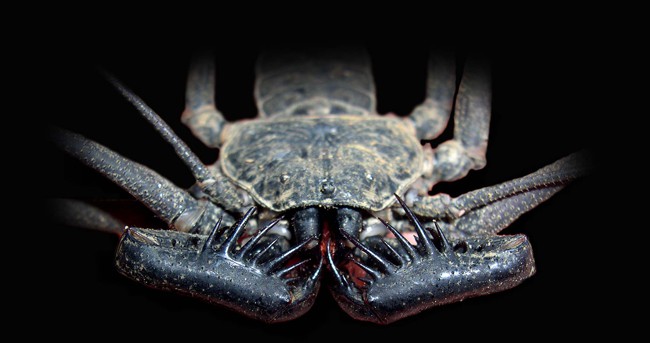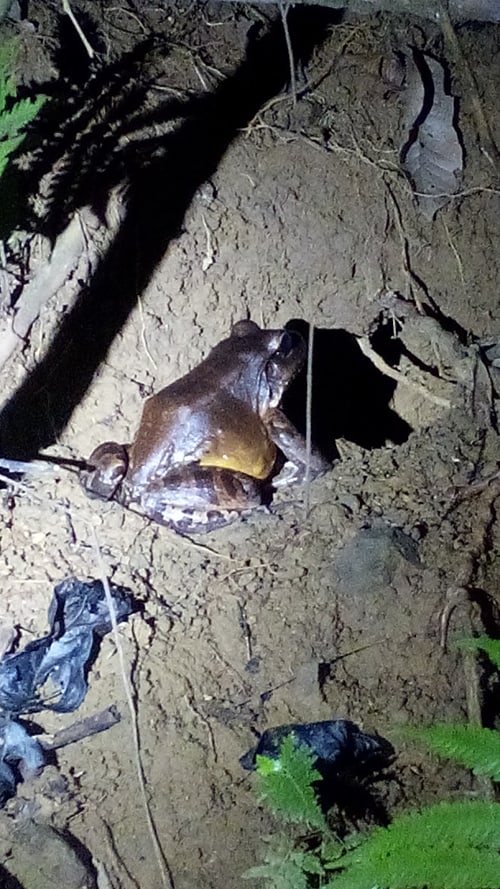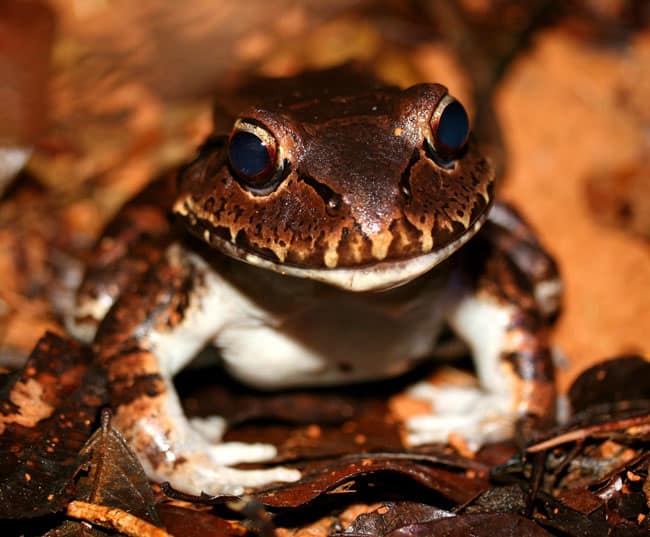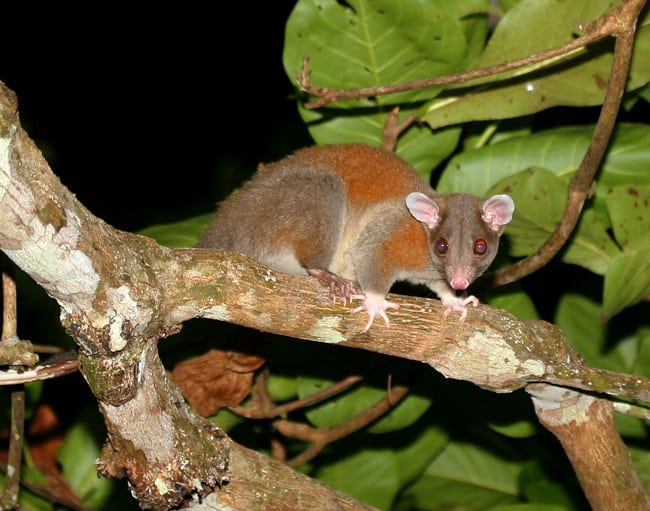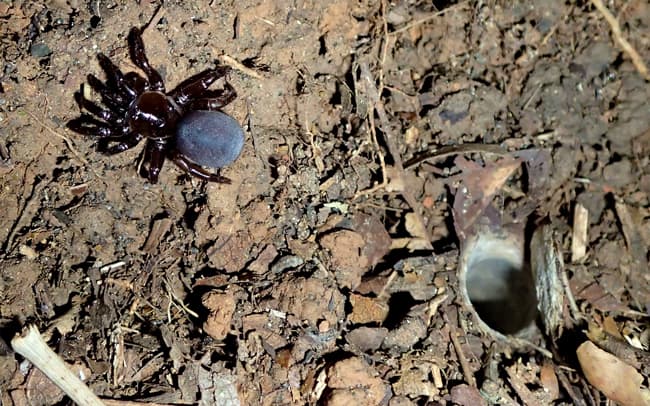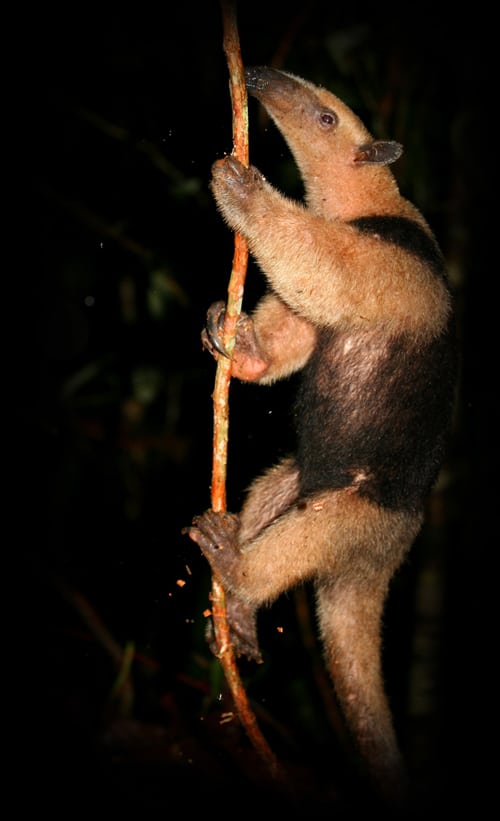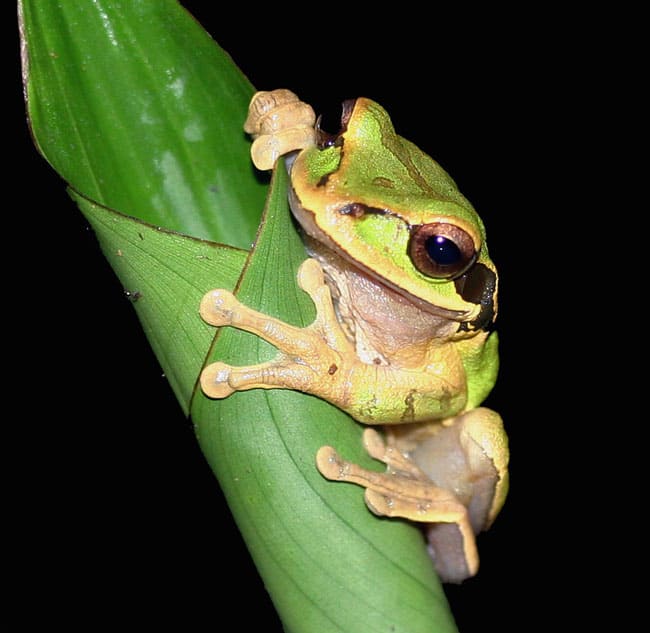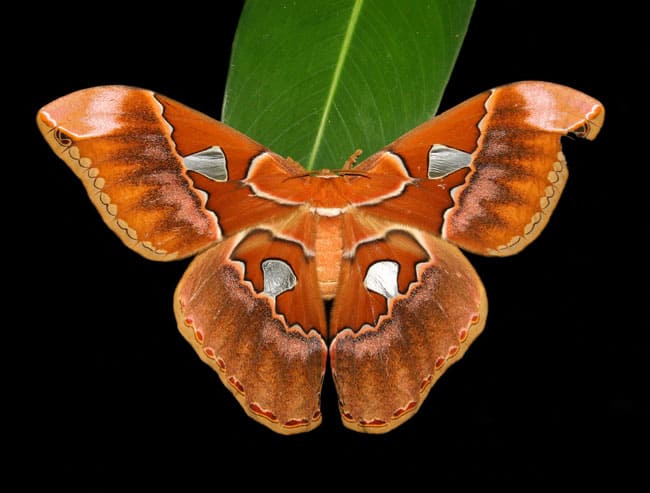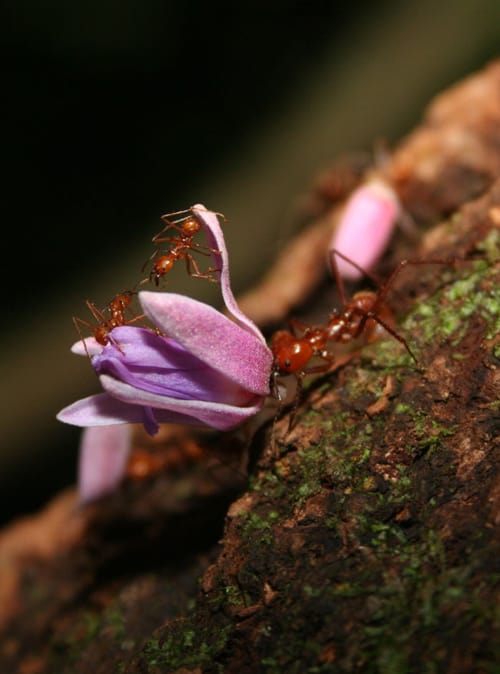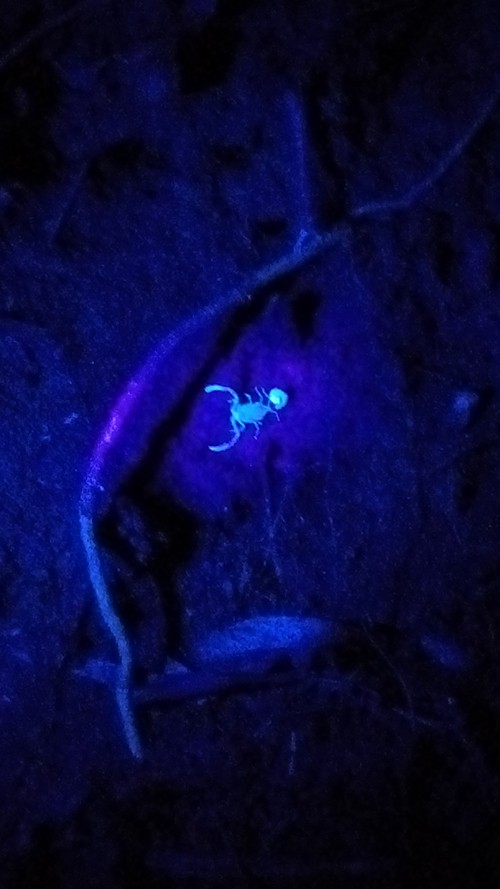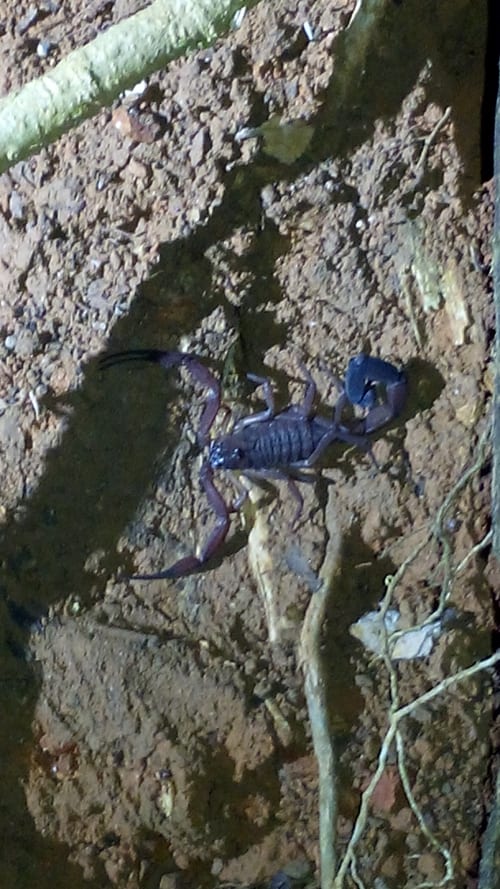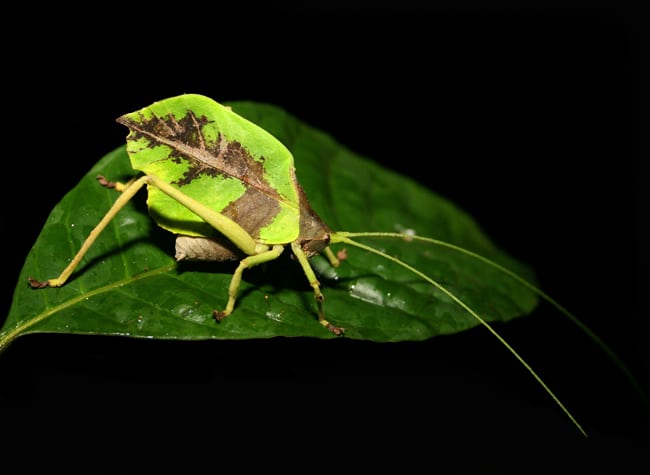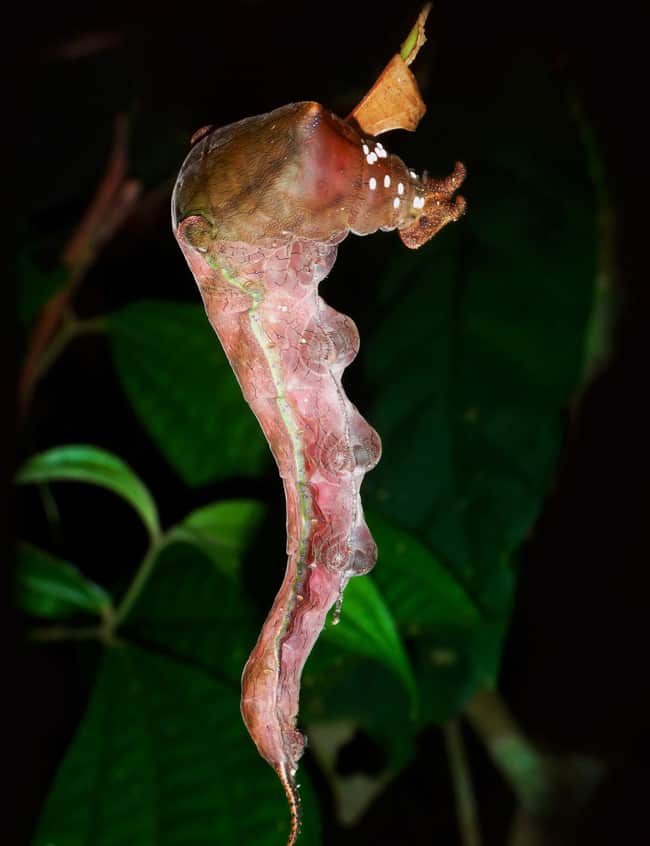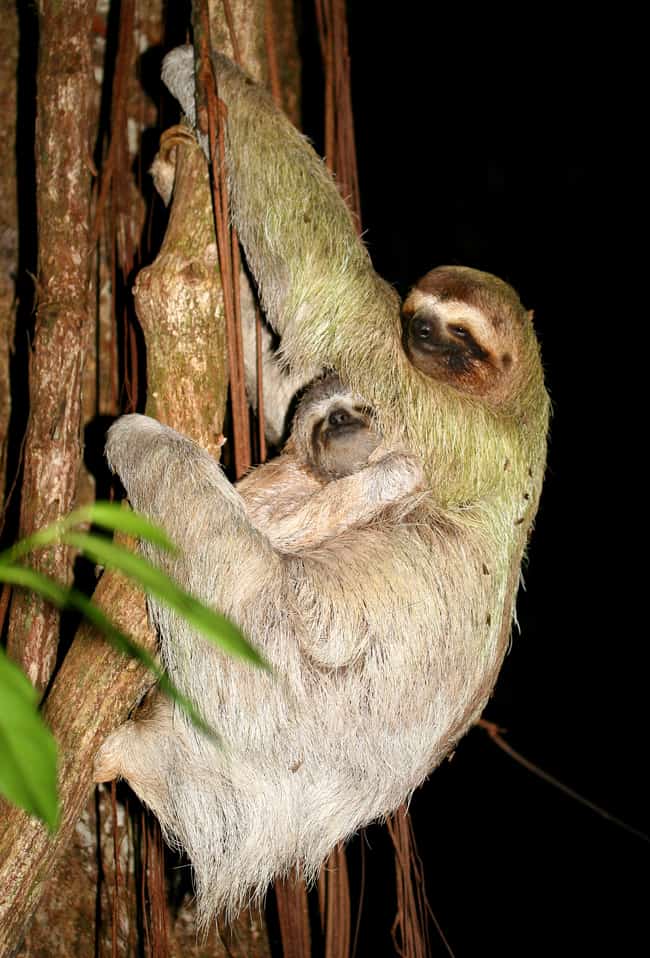DRAKE BAY, Puntarenas — A half-hour into our night tour at La Paloma Lodge to see spiders, insects, frogs and other creatures, it started to rain. “We’re going to get a little rain,” said Tracie Stice, the locally renowned expert in insects and arachnids known as the “Bug Lady,” in her calm and soothing voice, even before the first drops fell, “so protect your devices.”
I was wearing shorts, sports shoes and a handsome button-up short-sleeve shirt, and there wasn’t an easy way to protect my “devices” — two phones to record audio and take pictures — except to stuff them in my pockets and hope my pants didn’t get too soaked.
As the rain moved in, its pitter-patter soaking us all in watery splatter, Tracie reassured us that if it were really going to pour, we would be able to tell because many of the spiders would have taken down their webs and gone into hiding.
“How do they know if it’s going to pour?” I asked her.
I expected her to say something like “Instinct,” but instead she paused and gave me a thoughtful and scientific answer about how spiders can sense changes in air pressure, but the precise mechanism whereby they can predict the weather is not fully understood.
It was a good demonstration of the quiet erudition that has made Tracie, along with husband Gianfranco Gómez, famous as leaders of the most popular tours in the dark in Drake Bay since 1997, the “Night Tour with Tracie the Bug Lady.”
Before the rain started, Tracie gathered our group in a semicircle to address some safety concerns: “Watch every step you take” (to avoid stepping on a snake); “Try not to pick anything up off the path” (snakes, spiders, scorpions); and “Don’t reach into the vegetation” (all of the above).
“There’s some very good reasons why,” Tracie said. “And I’m sure we’ll see just a few tonight.”
And with that, she said, “Let’s take a look at our first spider.”
I wondered how she was going to find a spider, as we were standing on a trail where I couldn’t see any spider webs.
“Now at this moment we are completely surrounded by literally thousands of spiders,” she said. (Cue theme from “Arachnophobia.”)
She turned to my son Jordan, 25, and said, “There’s a spider right behind you.” We formed a new semicircle around this spot.
“The spider is right underneath this leaf,” she said, turning the leaf over. “And, uh, let’s see if we can bring this little one out. … There we go. And there’s a spider. … Does anybody not see it?”
There was indeed a tiny spider where she pointed.
“It is very small, but you could have actually spotted that yourselves, or even perhaps one much, much smaller,” she said. “It is the easiest thing in the world to do when you have a headlamp on.”
The secret, it turns out, is “eye shine.” When you shine a headlamp around you in a tropical jungle, the darkness lights up with little sparkles. These are the eyes of spiders, if not snakes or frogs or mammals.
“Nearly everywhere you look, you’re going to see a little green sparkle,” Tracie said. “It looks like an emerald, but that is the eye shine of your spider.”
But not all that sparkles is alive, she said.
“When you look around, you’re going to see a really clear sparkle,” she said. “If you see that, don’t get too excited. That is a water drop.”
How do you tell the difference?
“There’s a great, great trick,” she said. “Just take your headlamp off or bring your handheld light low. Shine it on your object with your light down here. If it still sparkles here [down low], it’s not a creature, because we only see those creatures’ eyes at night when our light is up here [up high].
“The reason why it works: They’re nocturnal animals, they’ve got a little tinted mirror behind the retina, and so when you shine your light beam into their eyes, it hits this mirror and then bounces back into your own eyes. If you’ve got your light low, you’ll never experience the angle of reflection.”
Who knew?
“And you can see snakes this way,” Tracie said. “You can find frogs from perhaps 100 meters away. With the mammals, with some exceptions, they tend to have very bright eye shine.”
Jordan remarked on seeing “little sparkles like discarded gemstones” all around him, and I saw them too.
I spotted a centipede, or perhaps a millipede, and showed it to Tracie and asked, “Are millipedes poisonous?”
“They release gases from their bodies,” she said. “It depends on the species of millipede, what chemical they will emit. Some emit cyanide gas. Others release a chemical structurally identical to Quaaludes. And then — this is really interesting — in Venezuela they actually found a species that releases a really good mosquito repellent.
“They found it’s actually more powerful than military-grade bug repellent. And the monkeys, the capuchin monkeys in Venezuela, have actually learned to take this species of millipede and rub it through their fur, just as the mosquito population is about to go out of control.”
“I should get a millipede on a leash,” said Jordan.
“People who study millipedes, they actually do put them on leashes,” said Tracie. “I can send you some links if you’re interested.”
At this point, through a scientific phenomenon known as “user error,” my audio recorder stopped recording, which is why I don’t have a lot of live quotes after this, although Tracie sent me a ton of information by email later.
I kept snapping pictures, and I took several when Tracie found a tailless whip scorpion (Paraphrynus laevifrons), a creepy but harmless arachnid that she picked up with her hand.
“Technically known as amblypygids, tailless whip scorpions are one on the most beautifully designed arachnids in the rain forest,” Tracie wrote in an email. “They detect their prey, which includes everything from insects to small frogs and lizards, by tapping around a pair of very long, antennae-like legs. Once the prey is detected, they swiftly lunge out a pair of spiny appendages called pedipalps. Amblypygids contain no poison glands and are completely harmless to humans. Prey is eaten alive.”
Ah, sweet, so humans don’t have to worry about amblypygids and pedipalps? Whew.
We found a large, poisonous frog called the smoky jungle frog (Leptodactylus savagei), the largest in Costa Rica, which we were told eats anything it can fit in its mouth (but woe to anything that eats it).
“The smoky jungle frog is Costa Rica’s largest species of frog and second largest amphibian, only rivaled in size by the giant marine toad,” Tracie emailed. “It has a voracious appetite to match its equally impressive stature. Prey items include bats, baby birds, snakes, scorpions and even other amphibians, including the poison dart frogs.”
Tracie heard Gian snapping his fingers, indicating the presence of a mammal, and we switched from the red to the white lights in our headlamps and hurried up the path to see a mouse-like animal scurrying along a power line. It turned out to be a Central American woolly opossum (Caluromys derbianus), a creature that I didn’t even know existed.
Gian, whose expertise is creatures with 0-4 legs (snakes, frogs, lizards and strange opossums), told us all about this nocturnal, fruit-loving marsupial, which froze on the power line as if posing for pictures.
Woolly opossum females are pregnant for only about two weeks, then give birth to anywhere from one to six young, which are so small that scientists call them “larvae.” The newly born larvae crawl into the mother’s pouch, where they develop for about two and a half months, and then they finish their development in a nest in the trees. The young are weaned in about four months and become mature in seven to nine months.
Tracie, who has a degree in biology with an emphasis in entomology, specializes in creatures with six legs, eight legs or more (insects, spiders, scorpions, centipedes), and we moved on to find more of these.
We came to the pièce de résistance, one of Tracie’s greatest finds: a trapdoor spider that, according to one of the world’s leading experts on this group, Dr. Jason Bond, may be completely new to science.
Tracie humbly added that in her line of work it would not be unusual to discover a previously unknown species, as there are so many.
She led us to a vertical outcropping of rock along the trail that was covered in green moss, where there was no evidence of anything living except plants.
But then she zeroed in one spot, and with her chopstick-like stick, she popped open a tiny round door, the front portal to the home of a trapdoor spider (genus Ummidia).
Spider enthusiasts say spotting a trapdoor spider should be on the Top 5 bucket list of any arachnophile, Tracie said, and I wouldn’t disagree.
The spider was small, black and looked pretty harmless, hunkered down in its little tunnel, probably wondering how the hell somebody popped open its front door.
Tracie said this spider survives by detecting motion outside the door, and it can tell by the size of the disturbance whether it should jump out and eat the invader or stay put to avoid being eaten.
Tracie said a trapdoor spider will spend its entire life in the same burrow unless some catastrophe destroys it, like a landslide caused by heavy rains. I reflected that it’s got to be a terribly boring existence, spending your whole life in a tiny little hole (with no TV or Internet).
Tracie pried into three trapdoor spider homes in a row, and we witnessed three amusing behaviors. The first time, she opened the circular door and it stayed open, the spider scurrying back to avoid the invader.
The second time, she opened a door and the spider immediately slammed it shut. Visitors unwelcome!
The third time, she pried at the door and the alert spider held it shut before she could get it open. Tracie said if she were to force it open, the door could break, endangering the spider’s life. It would have to build a new home and, until then, would be vulnerable to predators and desiccation. Great care should be taken with trapdoor spiders, she said.
About this time, the first spider slammed its door shut — “Keep out!” — and we all laughed.
Tracie said trapdoor spiders actually have different “personalities,” some of them timid, some of them bold, and we were witnessing this with our own eyes.
This is about the time it started to rain, and the more it rained the more I envied the spiders in their waterproof burrows.
Tracie kept talking calmly, with a steady stream of water now falling on her thick red hair, and I had the distinct impression that she was totally oblivious to the rain, like a jungle frog or an aquatic bird.
After five or ten minutes of steady drizzle, two or three older ladies opted out and said they were heading back to their rooms. Tracie, not wanting them to get lost in the dark, called Gianfranco to escort them back to their hotel.
I noticed that Tracie called her husband from a phone encased in weather-protected plastic, but she herself wore no rain gear, nothing but a short-sleeve black top and long blue jeans. I would not be surprised if she avoids rain gear because she doesn’t want to be more comfortable than her unprepared guests.
One lady who stayed behind gently asked how long this tour would last, and Tracie said until 10, as scheduled — an hour away.
I have to admit I thought of throwing in the towel and fleeing to the warmth of my room, but how wimpy would that be? What was I, an ice cream cone that would melt in the rain?
It helped when Tracie said, “I don’t think we’re going to get any wetter than we are already.”
True that!
We found a scorpion (Centruroides limbatus), this time not tailless, but with a tail that packs a painful sting. Tracie pulled an ultraviolet flashlight out of her bag of tricks and illuminated this eight-legged creature, which to my amazement glowed a bright, fluorescent blue.
“The best way to find scorpions at night is with a handheld UV flashlight — and the results are nothing less than magical,” Tracie wrote me by email. “All scorpions in the world possess a layer in their exoskeleton that, when exposed to UV light, will cause them to fluoresce like neon sculptures in the night.”
Of the Centruroides bicolor scorpion, which we also spotted, Tracie wrote: “Scorpions are built like a well-armored tank. Their tough exoskeleton actually contains heavy metals like zinc and magnesium, and in higher concentrations than any other member of the arachnid world. These metals essentially act like the metal tips found on the heels of shoes. They prevent wear on those body parts that dole out a lot of punishing blows like the pincers and the venom-injecting spine on the tail.”
Tracie showed us three marvels of camouflage: katydids that looked like leaves (Mimetica sp.), common rain frogs (Craugastor fitzingeri) that blend in seamlessly with the jungle floor, and a big, hanging butterfly caterpillar (Archaeoprepona demophon centralis) that looked like a dead leaf.
“Mimetica katydids are true masters at the art of deception and one of the finest examples of plant mimicry in the animal kingdom,” Tracie said by email. “Every detail of this insect’s body resembles a leaf. During the day their exquisite camouflage helps them go undetected by monkeys, birds, and other predators.”
Of the caterpillar, Tracie wrote, “It’s been said camouflage is the ‘art of losing one’s identity.’ When you are a tasty caterpillar, what better disguise is there than looking like a curled, brown tip of a damaged leaf? Dangling from the midline of a leaf it has partially eaten, the Archaeoprepona caterpillar blends perfectly with the surrounding vegetation. While this may protect the caterpillar from birds, it’s not enough to protect it from a more sinister fate. The white dots on this individual are tachinid fly eggs. Once the caterpillar pupates, the maggots will begin to devour the helpless Archaeoprepona.”
We saw an orb spider cleaning debris out of its web. They eat their webs at night and make new ones again the next day, Tracie said.
“Many orb spiders take down their web just before sunrise,” Tracie says. “Some spiders will then eat the rolled-up silk. By doing this, they are actually able to recycle about 90 percent of the components for the next night’s spinning.”
A more disturbing spider we spotted was a fellow called Cyclosa, with a web that looked like a little twig had fallen into it.
“Cyclosa the spider is the ‘bone collector’ of the arachnid world,” Tracie wrote. “When we observe the web, it looks as though a stick has fallen into the orb. On closer inspection, though, one can see that what looks like a stick is really the remains of our spider’s victims! The spider creates this corpse-laden trash line with a little gap where it can squeeze in and perfectly conceal itself. It becomes virtually undetectable not only to our eyes, but to their most feared enemies as well — parasitic wasps.”
To quote “Alice in Wonderland,” “Curiouser and curiouser.”
But wait, things get really weird when you consider the Ctenus wandering spider, which not only cannibalizes other spiders but will sometimes eat its own body parts.
“Ctenus wandering spiders are mostly ground-dwelling spiders,” Tracie says. “Much of their diet is comprised of other spiders. If in the attempt to take down prey, the spider is injured and starts bleeding from a leg, it will quickly self-amputate by biting off the injured limb. This stops the blood flow. Often, if not being pursued, the spider will go on to suck the juices from the lost leg to regain some of the nutrients.”
Gian showed us a distant three-toed sloth, high in the trees, and remarked on how they descend to the ground once a week to defecate. A tour guide at Hacienda Baru had told me they did this to avoid attracting predators by scattering their feces far and wide from the treetops.
But Gian had a completely different explanation, saying sloths defecate on the ground because of the symbiotic relationship between them and the hundreds of moths and beetles living in their fur, which lay their eggs in the sloth’s dung. Green algae also grows on the sloths, helping to camouflage them and also providing the sloths with nitrogen and phosphorus nutrients missing from their diet. The algae, in turn, thrives on the decayed bodies and feces of the insects.
At 10 p.m., after an intellectually fascinating but very wet hike, Tracie escorted us back to our room at La Paloma Lodge, and we said a warm goodbye.
A very nice bonus arrived by email a few days later: a link with a list of all the creatures we had seen, with outstanding photos and excellent descriptions. This is a service Tracie and Gian are happy to provide to anyone who asks, and it struck me as above and beyond the call of duty.
Back in our room, Jordan and I were delighted to find that La Paloma Lodge had left us two plates of tasty flan and two glasses of red wine (we had missed dessert because our tour started at 7:45). We were even more delighted to change out of our soaked clothes, dry off and climb into our five-star beds.
The only bugs awaiting us there, thank goodness, were in our dreams.
IF YOU GO
Contact: The Night Tour
Website: http://www.thenighttour.com
Where it’s available: A list of Drake Bay hotels where the tour is offered is at http://www.thenighttour.com/index.htm.
What to bring: Rain gear!


